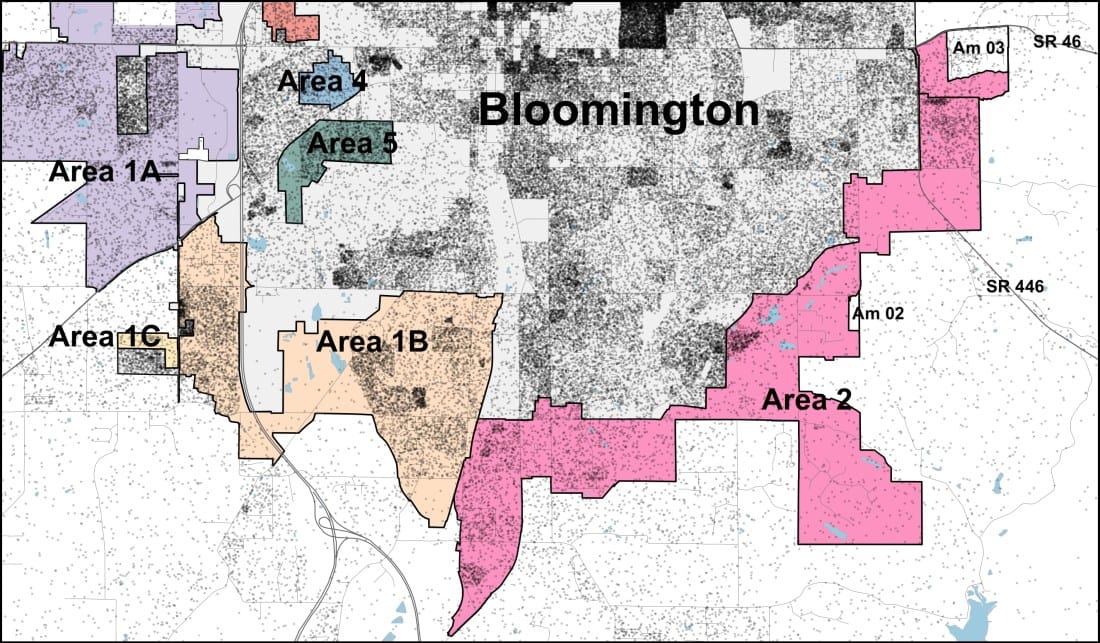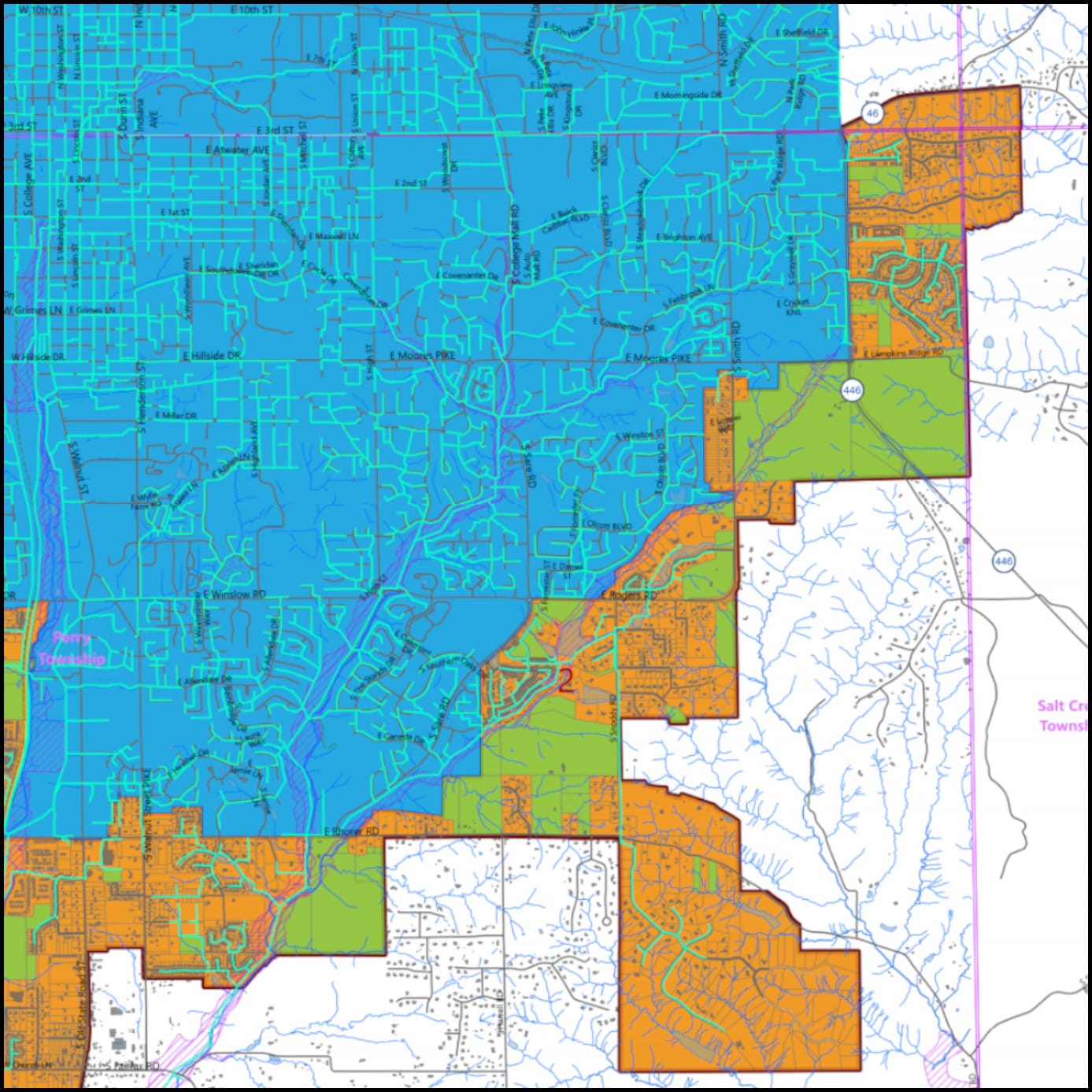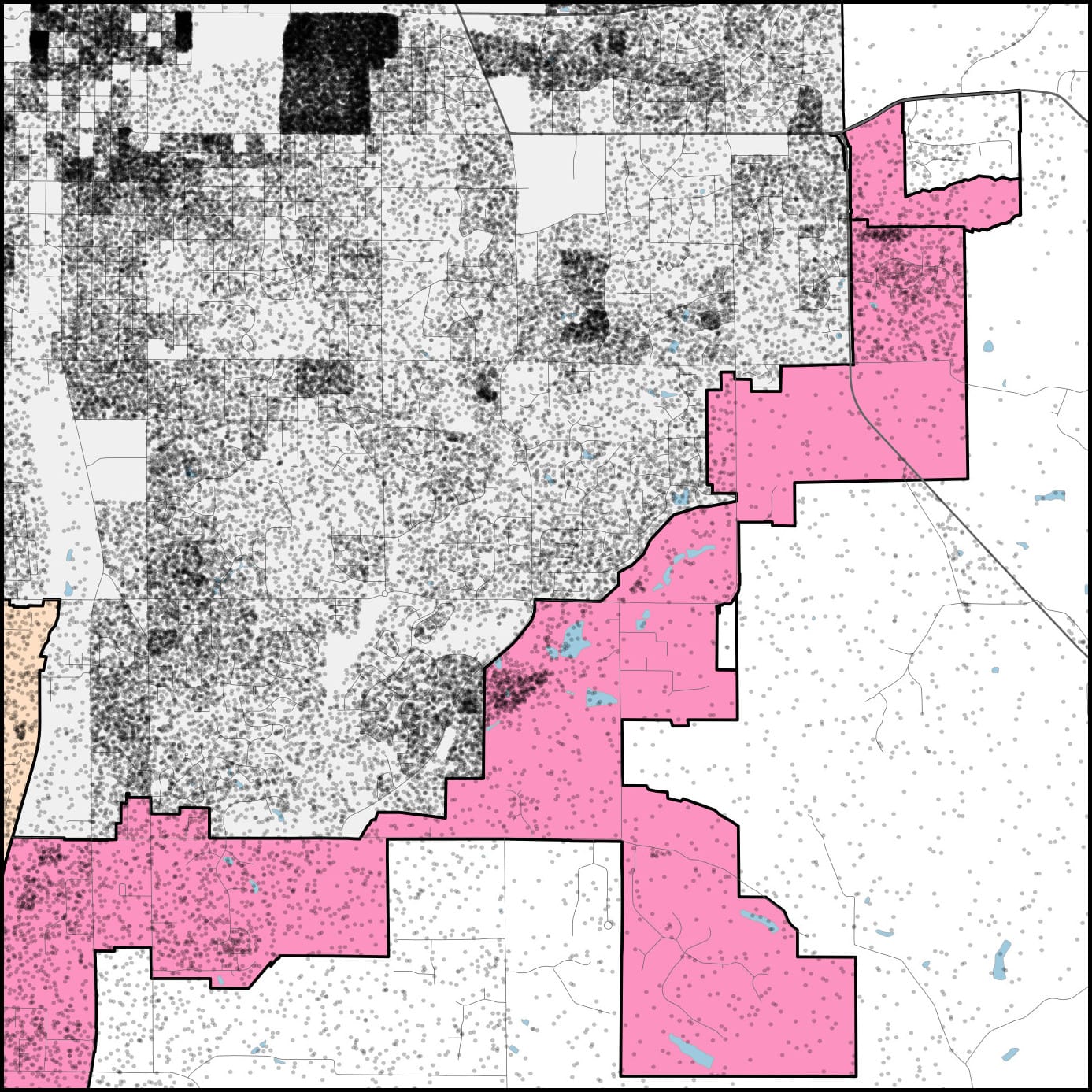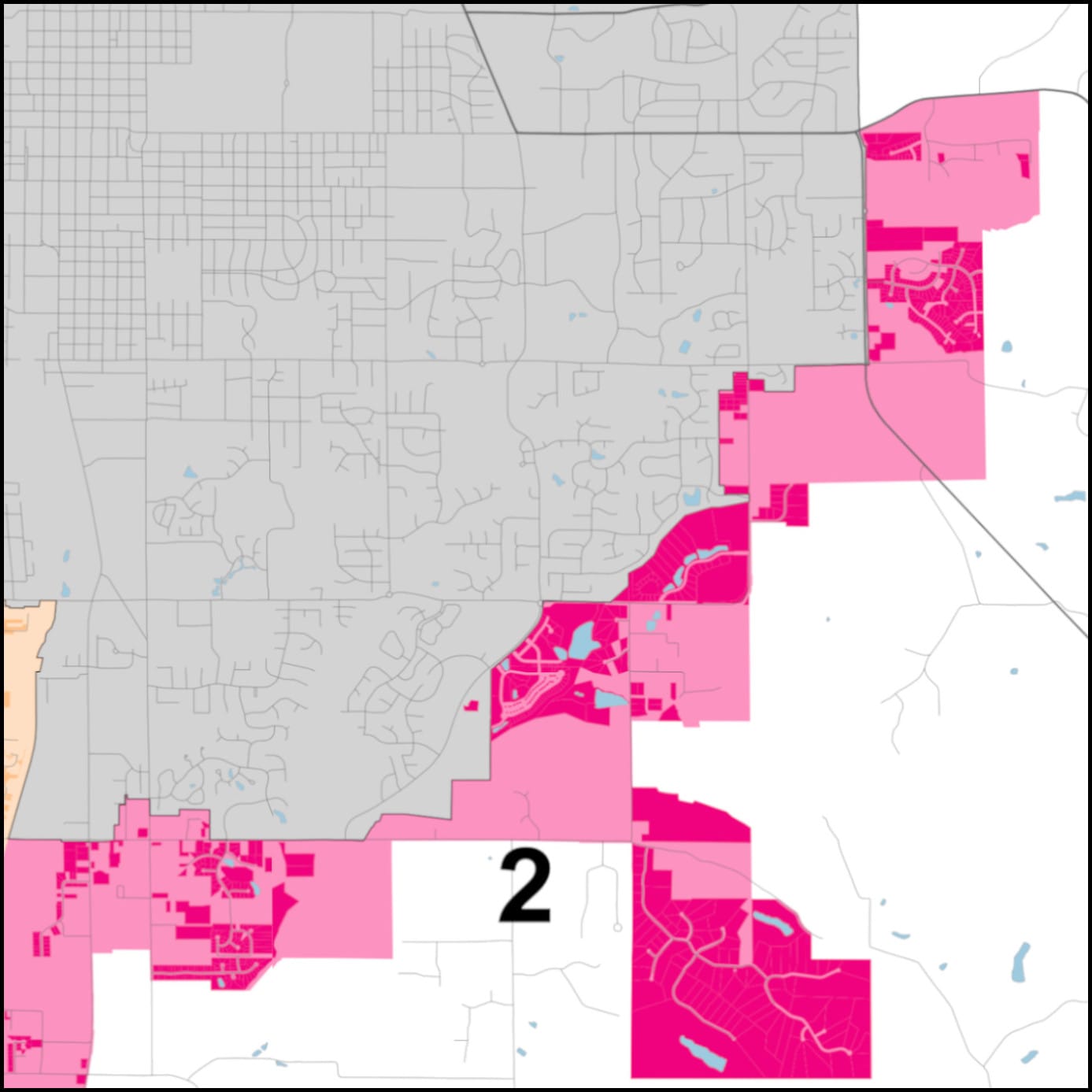Bloomington annexation now two small chunks smaller, votes set for Sept. 15


Bloomington’s city council voted on Tuesday night to exclude two small chunks from one of the proposed areas in the currently pending eight-area annexation plan.
The chunks that are no longer on the table to be made a part of the city of Bloomington, came from Area 2, which also goes by the label “South-East Bloomington Annexation Area.” It wraps around the southeast part of the city, extending from SR 46 on the east, to the Rogers and Walnut area on the south.
Separate votes on the eight annexation areas are set for the city council’s Sept. 15 meeting.
Area 2 no longer extends all the way to SR 46 for its whole width, based on Amendment 03, which was approved on Tuesday night. On an 8–1 vote of the council, the Edgewood Hills neighborhood, accessible from SR 46 via Lori Lane, was removed from the annexation plan. It was Kate Rosenbarger who dissented on the vote.
The Edgewood Hills chunk included 86 parcels out of the more than 6,600 that are a part of the annexation plan.
A slightly bigger chunk that was proposed to be removed in the same general vicinity—which included Edgewood Hills plus an additional L-shaped piece right on the city border—did not have enough support for removal. Amendment 04 failed on a 3–6 vote, with support from its sponsor Ron Smith, who was joined only by Susan Sandberg and Dave Rollo.
Getting unanimous support from the council for removal from the annexation plan was a five-parcel piece of territory, south of the bend where Rogers Road curves north to become Smith Road.
The biggest piece of the territory removed by Amendment 02 is a part of the Sycamore Land trust. So it has little potential for future development or additional property tax revenue to the city.



Amendment 02 was sponsored by Sue Sgambelluri. Isabel Piedmont-Smith asked Sgambelluri if there were other parcels in the proposed annexation area that were currently undeveloped and had little potential for future development. What was different about the five parcels Sgambelluri wanted to remove?
Sgambelluri replied, “These were the parcels that were brought to my attention, and for which I was asked for help. And so that’s what I focused on.”
Corporation counsel Philippa Guthrie told the council that the five parcels in question were, in fact, different from other parcels that might look undeveloped. Sometimes those parcels are actually “primed for development,” which was not the case of the five parcels in Amendment 02, she said. The parcels have no sewer service, no water service, and there’s only one structure on all of the parcels, Guthrie said.
Guthrie said the administration’s position was neutral on the question of removing the five parcels from the annexation plan.
On the subsequent Amendment 03, which removed the Edgewood Hills neighborhood from the annexation plan, Guthrie said the administration was not neutral. Guthrie told the council that the administration was opposed to removing Edgewood Hills from the annexation plan.
Reasons that Guthrie gave for annexing Edgewood Hills included its close proximity to the city. “Edgewood Hills is right next to the city,” Guthrie said. She continued, “Essentially, there’s one neighborhood in between it and the city. It is exactly the kind of residential neighborhood that we have been bringing into Bloomington for over 100 years.”
Guthrie added,“[Edgewood Hills] is appropriate, actually, for a number of city services including sanitation, road maintenance, and snow plowing.” Guthrie described the habits of Edgewood Hills residents like this: “Now, they turn out of Lori Lane and then they go to the city and use the amenities just like the rest of the community. So they are already a part of the community. They go to work in the city, they grocery shop there.”
Councilmembers disagreed with the administration’s position.
Sgambelluri, who helped sponsor the amendment, described it as “very hilly and rocky” and surrounded on both sides by Hoosier National Forest.
A co-sponsor, Steve Volan, described the neighborhood as essentially isolated from Cedar Hills, which is the neighborhood to the west—the one buffer between Edgewood Hills and the city.
Dave Rollo said the opinion of those property owners whose land would be annexed was a factor for him: “The desire of those to be annexed matters to me as well. So I’d like this to be a cooperative approach. And if a large number of people are not in favor, that will matter, in my judgment.”
Kate Rosenbarger, who cast the sole vote of dissent on removing Edgewood Hills, said, “I think leaving it out would make the map look really weird.”
The removal of a larger chunk of territory, which included Edgewood Hills, failed on a 3-6 vote. Only Ron Smith, Susan Sandberg, and Dave Rollo supported it.
The amendment foundered on the fact that it removed the Cedar Hills neighborhood, in addition to Heritage Woods Road.
It was mostly just the Heritage Woods Road neighborhood that the amendment’s sponsor, Ron Smith, wanted to remove. Heritage Woods Road runs east-west and forms the bottom of the L in the L-shaped area that Smith’s amendment would have removed.
But if the bottom of the L were removed, that would also mean removing the vertical part of the L, which is the Cedar Hills neighborhood. That’s because leaving in Cedar Hills, but removing Heritage Woods Road, would disconnect Cedar Hills from the territory south of Heritage Road, yielding two disconnected pieces of Area 2. That would violate the requirement that an annexation area consist of one connected area.
A majority of councilmembers were not willing to leave out the Cedar Hills neighborhood, which is immediately adjacent to the city, just across SR 446. Most of its parcels have annexation waivers.
One of the arguments that Heritage Road had going for its removal appeared to fade for some councilmembers, when Guthrie said that the city of Bloomington was willing to provide services along the road. Guthrie said, “[Public works] said they would accept it and service it the way they do all the other roads that are in the city.”
Guthrie added, “I think one of the points was that it’s too narrow for our trucks. And we have a number of roads where the trucks go in and do their their work, and then back out. It’s just the way we do it, when a road is a little bit narrower.”
Bart Farrell, a resident of Heritage Road, responded to that news by saying, “I was flat-out surprised to hear the city would take over ownership [of the road].” Farrell continued, “We have a road association, not a homeowner’s association, to maintain our own road.”
Farrell tried to make a case that even if the city said it would provide road maintenance, the road was unlikely to get good service: “Think about it. We’re a mile long road, 35 homes, go nowhere. Where would we fit in the city’s priorities to maintain our road?”
Farrell wrapped up the point: “If the city was to take ownership, we could get snow in January, we wouldn’t be plowed till July. We’re just not on your priority list.”
Impoundment Funds
Two amendments approved on Tuesday did not involve maps. According to the state law on municipal annexation, an annexation ordinance has to include terms and conditions for impounding money in a special fund. Going into the fund are all of the city property taxes imposed on the annexed territory after the annexation takes effect that are not used to meet the basic services described in other parts of the state law—for at least three years.
The impounded property taxes have to be used to provide additional services that were not specified in the annexation plan, within five years after the effective date of the annexation.
At Tuesday’s meeting, Steve Unger, an attorney with Bose McKinney & Evans, the city’s outside annexation counsel, sketched out two tests that determine whether an impoundment fund is required.
The first test is that 60 percent or more of the parcels are one acre or smaller. The second test is whether at least three people per acre live in the annexation area. If both of those tests are passed, then an impoundment fund is required, Unger said.
The amendments approved on Tuesday added impoundment funds and advisory boards to the ordinances for Area 2 and Area 1A. The other six ordinances already included the creation of an impoundment fund, according to information in the city council’s meeting information packet.
The seven-member advisory board that is established in connection with each impoundment fund has membership prescribed by state statute: the township trustee of the township with the largest number of residents living in the annexation area; the member of the county council representing the district with the largest number of residents living within the annexation area; the city engineer (Andrew Cibor); and four owners of property in the annexation area, two of whom are appointed appointed by the Bloomington’s mayor and two by the Monroe County county commissioners.
For Area 2, the relevant township trustee and county councilor would be: Perry Township trustee Dan Combs; and county council District 2 representative Kate Wiltz.
For Area 1A, the township trustee and county councilor would be: Van Buren Township trustee Rita Barrow; and county council District 3 representative Marty Hawk.




Comments ()